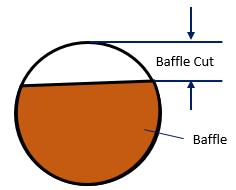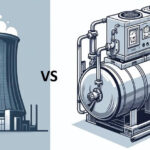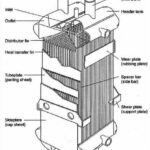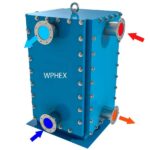Baffles in heat exchangers are often used as a core element in any shell and tube heat exchanger design. This short article will discuss the use of baffles and some common guidelines on their usage in heat exchangers.
What are baffles in heat exchangers used for?
There are several reasons for using baffles in heat exchangers, below is a list of functions that baffles are often used for.
To support tubes in heat exchangers.
Tubes must be supported at intervals not more than 1.5 m (5 ft), this mainly depends on the diameter of the tube and material of construction. The support intervals can be shorter where flow-induced vibrations occur in certain operations.
Supporting the tubes using baffles also prevents mechanical vibrations that can result in tubes touching each other and giving rise to leakages and failures mainly near tube sheets
To enhance heat transfer by directing the flow through the shell in a desired pattern.
This also increases the turbulence and reduces the stagnant pockets in the heat exchanger. We can also maintain a desired velocity by introducing baffles.

Types of baffles in heat exchangers
There are different types that used in heat exchangers, below are the popular ones
Segmental baffles
A plate type baffle maybe single segmental, double segmental or triple segmental. With the single and double segmental baffles are most frequently used as they divert the flow most effectively across the tubes.




Disk and Doughnut baffles
Has alternating outer rings and inner disks which directs the flow radially across the tube field. They all very effective in pressure drop to heat transfer conversion.

Orifice baffles
In this type of baffles the shell side fluid follows through the clearance between the tube outside diameter and the baffle hole diameter.

Rod baffles
This type is metal rods rather than plate metal baffles. The type is use wherever a very low-pressure drop is required. Rod baffles also eliminates the tube vibrations which occur with plate baffles when fluid velocities are high.
The flow in the shell side is mainly parallel to tube axis. Tubes are arranged with square pitch. Rods, with a diameter equal to the clearance between the tube rows, are attached to ring supports and placed between alternate tubes in both horizontal and vertical directions.
The normal rod diameter is 6.35 mm (0.25 inch) and each tube is supported on all four sides at several points along the exchanger

Rod baffles are mainly used when the pressure drop available is very low or there is a pressure drop issue.
What is a baffle cut?
This term is normally expressed in percentage of the shell inside diameter that is not covered by the baffle, and is defined as the height of segment that is cut in each baffle to allow the shell side fluid to flow across the baffle.
The normal recommended value of 20% to 25% cut of shell diameter is used in shell and tube heat exchanger design, the larger the cut the lower the pressure drop however this comes with a disadvantage on the heat transfer as the poorly distributed flow with large eddies is produces causing stagnant areas or dead spaces behind the baffles in the shell, this results in lower heat transfer coefficient. With a smaller cut the pressure drop is higher and the heat transfer coefficient is also higher.

The baffle cut orientation can differ from horizontal cut and vertical cut and varies between 15% and 45% of the shell inside diameter with 45% being a maximum cut for single segmental baffles. Reducing the baffle cut to below 20% to increase the shell side heat transfer coefficient or increasing the baffle cut beyond 35% to decrease the shell side pressure drop usually leads to poor designs.
To reduce the pressure drop in shell side without the increase of baffle cut beyond 35%; some strategies can be used, for example double segmental baffles, split shell flow using TEMA J type shell or cross flow shell using TEMA X type can be used to overcome the issue for shell side pressure drop.
What is Baffle to Tube Clearance?
Every tube inserted in baffle has a clearance between the tube outside diameter and the baffle hole diameter. This clearance allows the tubes to be inserted in to the baffle with ease. TEMA standards provide clearance optimum requirement values that is employed in industry. These requirements take in to account the spacing that need to be provided fir differential expansion and contraction between baffle plate and tubes. Certain amount of leakage through the clearances is permitted to reduce stagnant regions and to make turbulent conditions more uniform and reduce shell side pressure drop. The leakage also reduces deposits in stagnant areas.
If the clearances are large, it can cause excessive fluid bypassing resulting in fluid starving regions in shell with low fluid velocities
What is the minimum baffle spacing recommended?
Generally between 0.3 to 0.5 off the shell diameter with 50.8 mm (2 inch) being the minimum used
Equation:
0.3 * Shell diameter
to
0.5 * Shell diameter
So if for example we have a shell diameter of 356 mm (14 inch) then the minimum baffle spacing selected should be between 106.8 mm (4.2 inch) to 178 mm (7 inch).
See below for calculations:
0.3 * 356 mm = 106.8 mm (4.2 inch)
To
0.5 * 356 mm = 178 mm (7 inch)
With both values considered valid as they are both above the minimum recommended value of 50.8 mm (2 inch)
Useful books
- S. N. Raju, Fluid mechanics, Heat transfer, and Mass transfer chemical engineering practice, AIChE, 2011, John Wiley & Son, Inc., Publication
- S. Kakac, H. Liu, Heat exchangers selection, rating and thermal design, 3rd Edition, CRC Press










